The Marshall Star for November 22, 2023
The Marshall Star for November 22, 2023
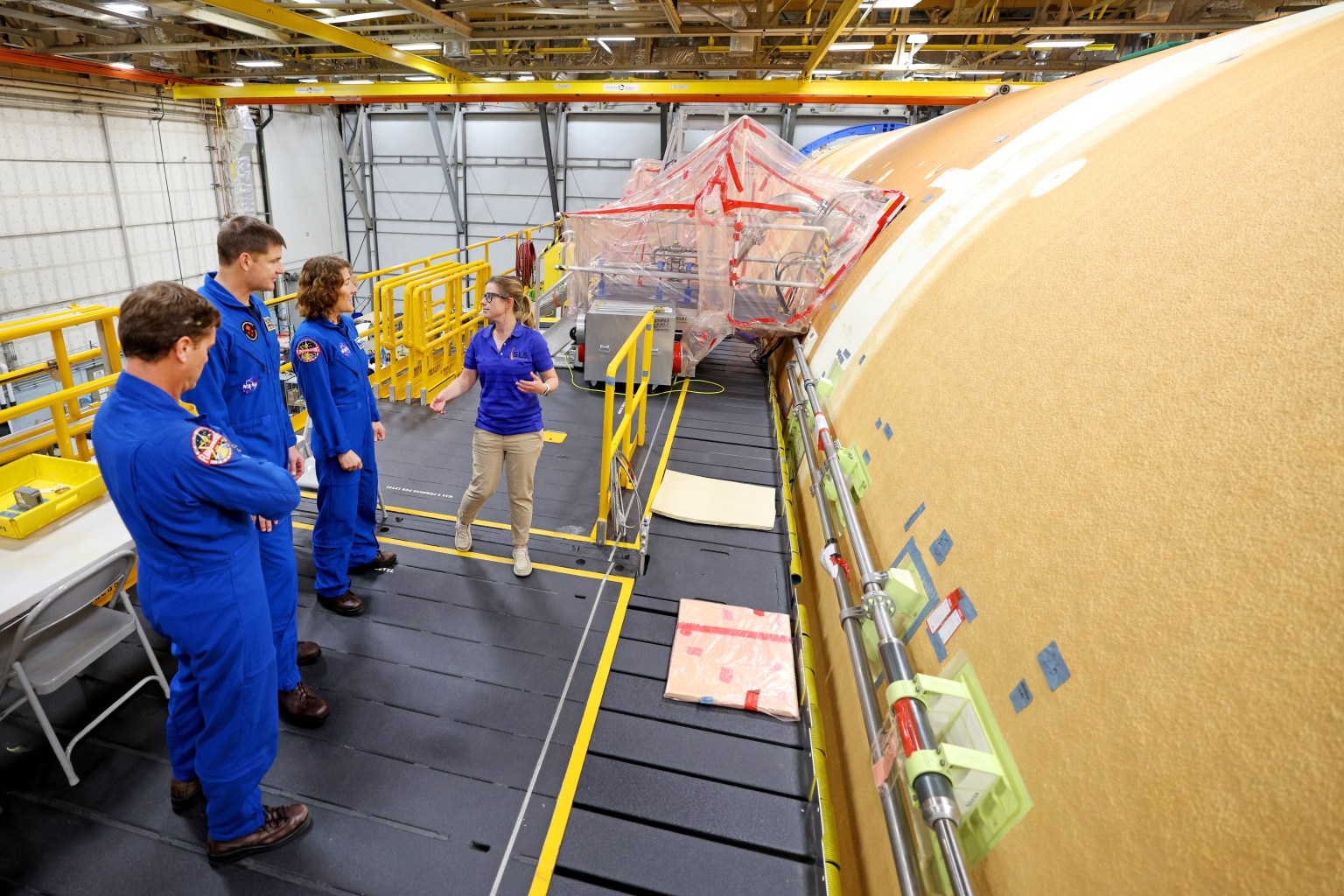
Artemis II Astronauts View SLS Core Stage at Michoud
Artemis II NASA astronauts Reid Wiseman and Christina Koch of NASA, and CSA (Canadian Space Agency) astronaut Jeremy Hansen viewed the core stage for the SLS (Space Launch System) rocket at the agency’s Michoud Assembly Facility on Nov. 16. The three astronauts, along with NASA’s Victor Glover, will launch atop the rocket stage to venture around the Moon on Artemis II, the first crewed flight for Artemis.
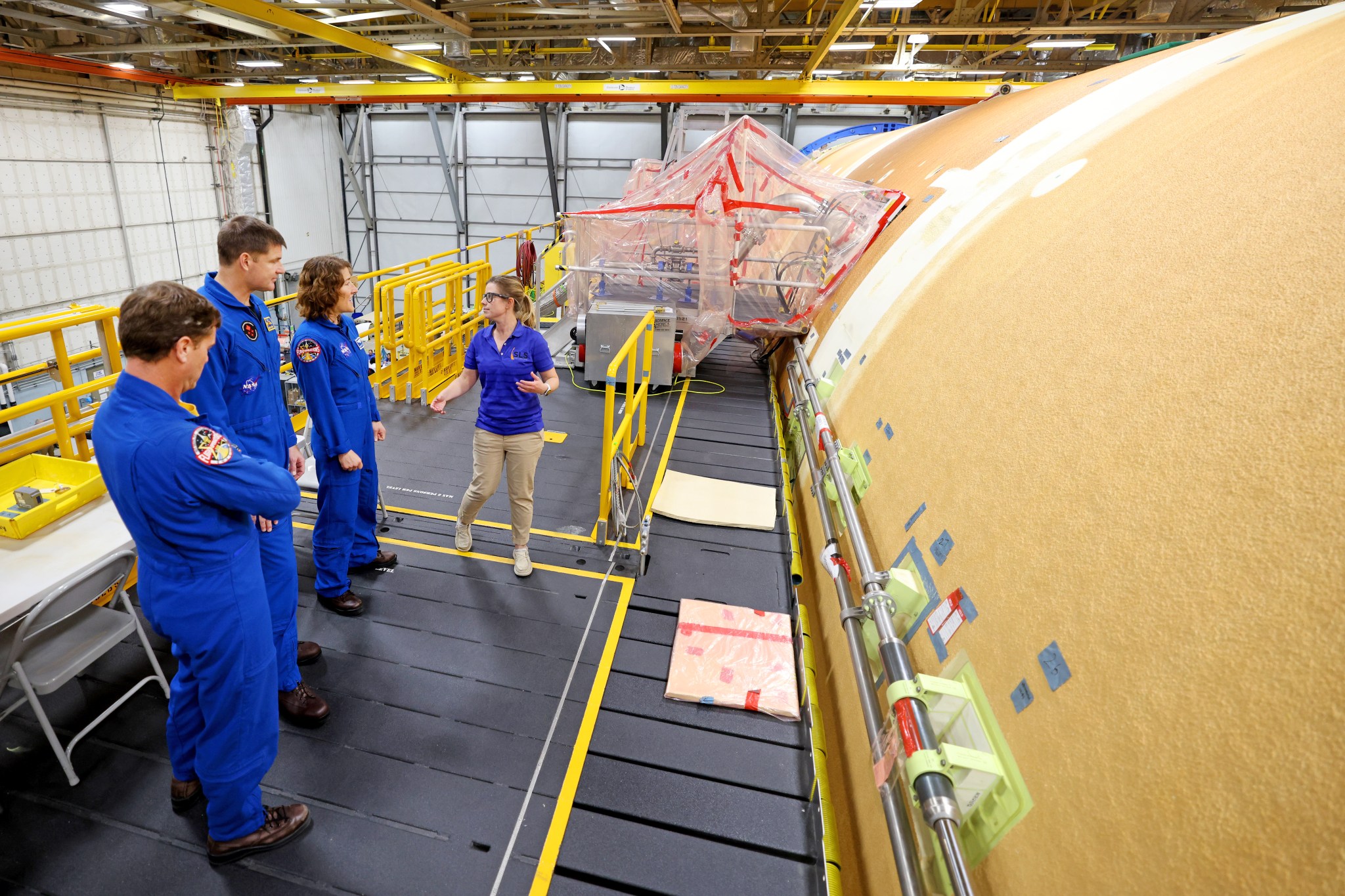
The SLS core stage, towering at 212 feet, is the backbone of the Moon rocket and includes two massive propellant tanks that collectively hold 733,000 gallons of propellant to help power the stage’s four RS-25 engines. NASA, Boeing, the core stage lead contractor, along with Aerojet Rocketdyne, an L3Harris Technologies company and the RS-25 engines lead contractor, are in the midst of conducting final integrated testing on the fully assembled rocket stage. At launch and during ascent to space, the Artemis astronauts inside NASA’s Orion spacecraft will feel the power of the rocket’s four RS-25 engines producing more than 2 million pounds of thrust for a full eight minutes. The mega rocket’s twin solid rocket boosters, which flank either side of the core stage, will each add an additional 3.6 million pounds of thrust for two minutes.

The astronauts’ visit to Michoud coincided with the first anniversary of the launch of Artemis I. The uncrewed flight test of SLS and Orion was the first in a series of increasingly complex missions for Artemis as the agency works to return humans to the lunar surface and develop a long-term presence there for discovery and exploration.
NASA is working to land the first woman and first person of color on the Moon under Artemis. SLS is part of NASA’s backbone for deep space exploration, along with the Orion spacecraft, advanced spacesuits and rovers, the Gateway in orbit around the Moon, and commercial human landing systems. SLS is the only rocket that can send Orion, astronauts, and supplies to the Moon in a single mission.
Mission Success is in Our Hands: Jeramie Broadway
Mission Success is in Our Hands is a safety initiative collaboration between NASA’s Marshall Space Flight Center and Jacobs. As part of the initiative, eight Marshall team members are featured in new testimonial banners placed around the center. This is the first in a Marshall Star series profiling team members featured in the testimonial banners.
Jeramie Broadway is the center strategy lead for the Office of the Center Director.

Before assuming this role, Broadway was senior technical assistant to the Marshall associate director, technical, from September 2021 to October 2022. In that capacity, he supported the development, coordination, and implementation of Marshall strategic planning and partnering within NASA and across industry and academia. Prior to that detail, he was the assistant manager of Marshall’s Partnerships and Formulation Office, providing strategic planning and business development support and creating new partnering and new mission opportunities for the center.
Broadway, a Dallas, Texas, native who joined NASA full-time in 2008, began his career in Marshall’s Materials and Processes Laboratory, supporting and leading production operations for the Ares I and Space Launch System program. Over the years, he served as project engineer or deputy project manager for a variety of work, including the Nuclear Cryogenic Propulsion Stage Project, for which he led development of advanced, high-temperature nuclear fuel materials. He was assistant chief engineer for launch vehicles for NASA’s Commercial Crew Program and assistant chief engineer for NASA’s Technology Demonstration Mission Program, managed for the agency at Marshall.
Question: What are some of your key responsibilities?
Broadway: Leading and implementing the center director’s strategic vision, leveraging, and integrating the strategic business units across the Marshall Center, one of NASA’s largest field installations, with nearly 7,000 on-site and near-site civil service and contractor employees and an annual budget of approximately $4 billion. Working closely in coordination and collaboration with every center organization to ensure Marshall’s planning, workflow, and business tactics align with the agency’s strategic priorities.
Question: How does your work support the safety and success of NASA and Marshall missions?
Broadway: My work as the center strategy lead is focused on the success and viability for the Marshall of the future. I work to pursue and capture programs, projects, and opportunities for Marshall to maintain ourselves as an engineering center of excellence. We work hard capturing opportunities to develop the skills, capabilities, and expertise to safely deliver on the vision and mission of the agency.
Question: What does the Mission Success Is In Our Hands initiative mean to you?
Broadway: Mission success is the responsibility of every single person at Marshall Space Flight Center, regardless of grade, position, or civil servant or support contractor. Everyone has a vital role in the success of Marshall and our ability to deliver on our mission. We all have the ability to lean forward, break down barriers, and strive for a culture that that says ‘yes, and…’.
Question: How can we work together better to achieve mission success?
Broadway: In this pursuits culture, it will take all of us to achieve the goals and objectives set forward by the agency and center leadership. We have a vibrant future with many opportunities coming our way and it will take all of us to make that vision a reality. It will take both our mission execution and our mission support organizations to get us there.
Marshall Makes Impact at University of Alabama’s 8th Annual Space Days
By Celine Smith
Team members from NASA’s Marshall Space Flight Center participated in the 8th annual Space Days at UA (University of Alabama) on Nov 14-16, where more than 500 students met with experts from NASA and aerospace companies to learn more about the space industry.
During the three-day program, Marshall team members conducted outreach presentations and updates about the Artemis missions, HLS (Human Landing System), and other NASA programs, as well as how students can get involved in NASA’s internship program.
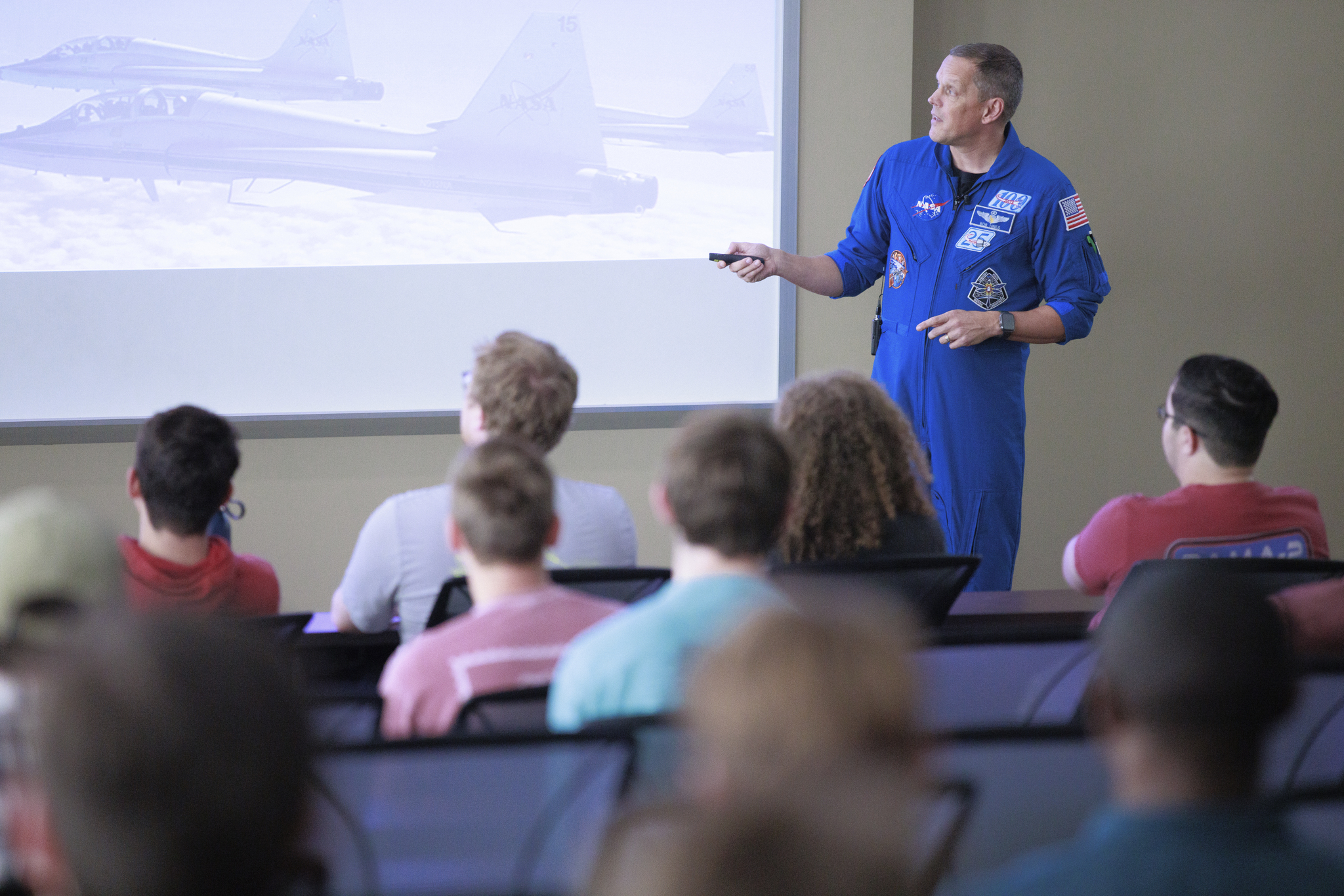
Kicking off the event was Aaron Houin, an engineer on the aerospace vehicle design and mission analysis team at Marshall. Houin delivered a detailed presentation on orbital mechanics and vehicle properties. Houin is no stranger to the classroom, as he is currently earning his doctorate at UA’s Astrodynamics and Space Research Laboratory and was eager to give back to his alma mater.
“Having been in their position studying the same theories, I emphasized how their coursework directly applies to physics-based modeling and trajectory design,” Houin said. “I’m hopeful sharing my experiences of transitioning from the classroom to the workplace will help others find similar success.”
The Marshall team also conducted an hour-long panel discussion and Q&A segment allowing students to learn more about the fields of aerospace and aeronautic research. Panelists included Christy Gattis, cross-program integration lead, and Kent Criswell, lead systems engineer, both representing the HLS team, as well as Tim Smith, senior mission manager of the TDM (Technology Demonstration Missions) program.
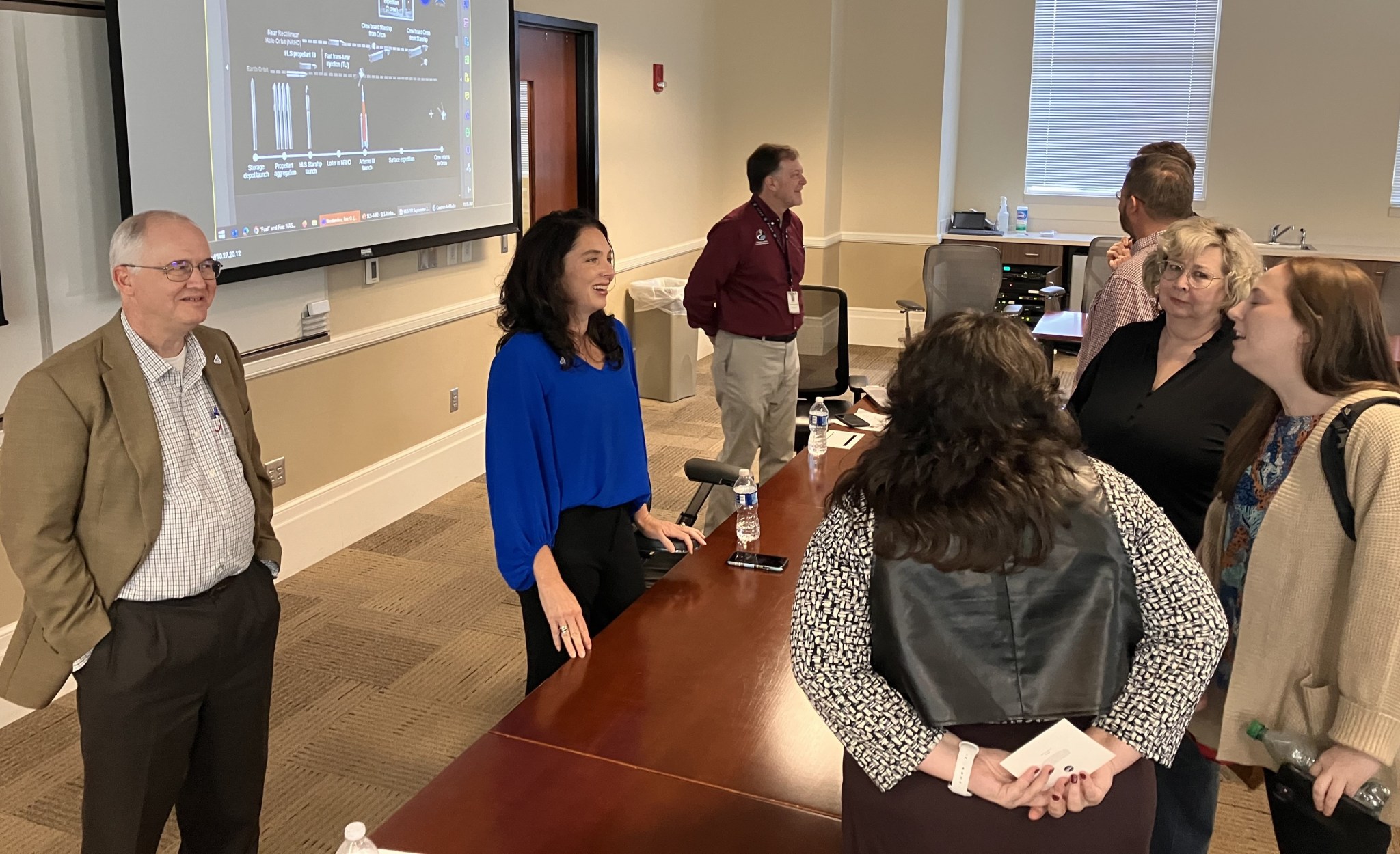
During the panel discussion, attendees were treated with a surprise guest speaker as Eric Vanderslice, stages structures sub element lead with SLS (Space Launch System), connected virtually from the Michoud Assembly Facility. Vanderslice shared insight about “America’s Rocket Factory” and progress for the agency’s Artemis II missions, including the recent installation of all four RS-25 engines onto the 212-ft-tall SLS core stage.
UA students also received a Tech Talk presentation focused on the SCaN (Space Communications and Navigation) program and related internship opportunities from team members from NASA’s Glenn Research Center and NASA Headquarters. Panelists included Dawn Brooks, program specialist at NASA Headquarters; Timothy Gallagher, senior project lead, and Molly Kearns, digital media specialist, all three representing SCaN’s Policy and Strategic Communications office.
And in true “One NASA” collaboration, joining the Glenn contingency for this Tech Talk was once again, Tim Smith, providing related updates on the Deep Space Optical Communications and the Laser Communications Relay Demonstration experiments.

The annual Space Days event concluded with NASA astronaut Bob Hines delivering a special presentation entitled, “An Astronaut’s Journey” to nearly 100 students, staff and industry partners. Hines completed his first spaceflight as a mission specialist for NASA’s SpaceX Crew-4 mission, serving as flight engineer of Expedition 67/68 aboard the International Space Station.
Space Days is hosted by the UA College of Engineering and their staff shared how crucial it is to have support from aerospace industry partners willing to visit campus and meet students. Key partners exhibiting and presenting included Lockheed Martin, United Launch Alliance, Alabama Space Grant Consortium, and others.
“By the time our students attend a career fair, apply for an internship, or pursue cooperative education, they will have learned about these companies in a smaller setting and begin to consider the many pathways to success,” said Tru Livaudais, director of external affairs for UA College of Engineering. “This event offers all UA students – regardless of majors and specialties – a chance to explore future career possibilities and how to be a part of the cutting-edge research and opportunities in the space industry.”
Smith, a Media Fusion employee, supports the Marshall Office of Communications.
NASA Telescope Data Becomes Music You Can Play
For millennia, musicians have looked to the heavens for inspiration. Now a new collaboration is enabling actual data from NASA telescopes to be used as the basis for original music that can be played by humans.
Since 2020, the “sonification” project at NASA’s Chandra X-ray Center has translated the digital data taken by telescopes into notes and sounds. This process allows the listener to experience the data through the sense of hearing instead of seeing it as images, a more common way to present astronomical data.

A new phase of the sonification project takes the data into different territory. Working with composer Sophie Kastner, the team has developed versions of the data that can be played by musicians.
“It’s like a writing a fictional story that is largely based on real facts,” said Kastner. “We are taking the data from space that has been translated into sound and putting a new and human twist on it.”
This pilot program focuses on data from a small region at the center of our Milky Way galaxy where a supermassive black hole resides. NASA’s Chandra X-ray Observatory, Hubble Space Telescope, and retired Spitzer Space Telescope have all studied this area, which spans about 400 light-years across.
“We’ve been working with these data, taken in X-ray, visible, and infrared light, for years,” said Kimberly Arcand, Chandra visualization and emerging technology scientist. “Translating these data into sound was a big step, and now with Sophie we are again trying something completely new for us.”
In the data sonification process, computers use algorithms to mathematically map the digital data from these telescopes to sounds that humans can perceive. Human musicians, however, have different capabilities than computers.
Kastner chose to focus on small sections of the image in order to make the data more playable for people. This also allowed her to create spotlights on certain parts of the image that are easily overlooked when the full sonification is played.
“I like to think of it as creating short vignettes of the data, and approaching it almost as if I was writing a film score for the image,” said Kastner. “I wanted to draw listener’s attention to smaller events in the greater data set.”
The result of this trial project is a new composition based upon and influenced by real data from NASA telescopes, but with a human take.
“In some ways, this is just another way for humans to interact with the night sky just as they have throughout recorded history,” says Arcand. “We are using different tools but the concept of being inspired by the heavens to make art remains the same.”
Kastner hopes to expand this pilot composition project to other objects in Chandra’s data sonification collection. She is also looking to bring in other musical collaborators who are interested in using the data in their pieces.
Sophie Kastner’s Galactic Center piece is entitled “Where Parallel Lines Converge.” If you are a musician who wants to try playing this sonification at home, check out the sheet music at: https://chandra.si.edu/sound/symphony.html.
The piece was recorded by Montreal based Ensemble Éclat conducted by Charles-Eric LaFontaine on July 19, 2023, at McGill University.
NASA’s Marshall Space Flight Center manages the Chandra program. The Smithsonian Astrophysical Observatory’s Chandra X-ray Center controls science operations from Cambridge, Massachusetts, and flight operations from Burlington, Massachusetts.
Read more from NASA’s Chandra X-ray Observatory.
Dietitian Rachel Brown Speaker for Nov. 28 Marshall Association Event
Rachel Brown, registered dietitian and certified diabetes care and education specialist, will be the guest speaker for the Marshall Association Speaker Series on Nov. 28.
The event will be 12-1 p.m. The event is free to attend and open to everyone via Teams. NASA Marshall Space Flight Center team members can attend in Building 4221, Conference Room 1103. The meeting topic follows this year’s theme of Breaking Boundaries.

A mom of two and a Huntsville resident since 2016, Brown is the owner of Rocket City Dietitian social media channels, where she focuses on promoting local food, fun, and fitness available in the Rocket City. She has a monthly TV segment on TN Valley Living promoting the local food scene and is a regular contributor to Huntsville Magazine, We Are Huntsville, and VisitHuntsville.org.
Email the Marshall Association for questions about the event. For more information on the Marshall Association and how to join, team members can visit their page on Inside Marshall.
Cube Quest Concludes: Wins, Lessons Learned from Centennial Challenge
By Savannah Bullard
Artemis I launched from NASA’s Kennedy Space Center on Nov. 16, 2022, penning a new era of space exploration and inching the agency closer to sending the first woman and first person of color to the lunar surface.
Aboard the Space Launch System (SLS) rocket were 10 small satellites, no bigger than shoeboxes, whose goal was to detach and capably perform operations near and beyond the Moon. One of those satellites was a product of the Cube Quest Challenge, a NASA-led prize competition that asked citizen innovators to design, build, and deliver flight-qualified satellites called CubeSats that could perform its mission independently of the Artemis I mission.

Cube Quest is the agency’s first in-space public prize competition. Opened in 2015, the challenge began with four ground-based tournaments, which awarded almost $500,000 in prizes. Three finalists emerged from the ground competition with a ticket to hitch a ride aboard the SLS as a secondary payload – and win the rest of the competition’s $5 million prize purse, NASA’s largest-ever prize offering to date – in 2022.
Of the three finalists, Team Miles was the sole team to make the trip on Artemis I successfully. Shortly after a successful deployment in space, controllers detected downlink signals and processed them to confirm whether the CubeSat was operational. This remains the latest update for the Team Miles CubeSat.
“We’re still celebrating the many wins that were borne out of Cube Quest,” said Centennial Challenges Program Manager Denise Morris. “The intent of the challenge was to reward citizen inventors who successfully advance the CubeSat technologies needed for operations on the Moon and beyond, and I believe we accomplished this.”
Innovation rarely comes without error, but according to Challenge Manager Naveen Vetcha, who supports Centennial Challenges through Jacobs Space Exploration Group, even after everything goes as expected, there is no guarantee that scientists will reach their desired outcomes.
“Given the magnitude of what we can and do accomplish every day at NASA, it comes with the territory that not every test, proposal, or idea will come out with 100 percent success,” Vetcha said. “We have set ambitious goals, and challenging ourselves to change what’s possible will inevitably end with examples of not meeting our stretch goals. But, with each failure comes more opportunities and lessons to carry forward. In the end, our competitors created technologies that will enable affordable deep space CubeSats, which, to me, is a big win.”
Although Team Miles may have made it furthest in the Cube Quest Challenge, having launched its CubeSat as a secondary payload aboard Artemis I, the team continues to participate in the challenge long after launch.
“From Team Miles, Miles Space LLC was created and is still in business,” said Jan McKenna, Team Miles’ project manager and safety lead. “Miles Space is developing and selling the propulsion system designed for our craft to commercial aerospace companies, and we’ve expanded to be able to create hardware for communications along with our CubeSat developments.”
The next steps for Miles Space LLC include seeing through their active patent applications, establishing relationships with potential clients, and continuing to hunt for a connection with their flying CubeSat. Another finalist team, Cislunar Explorers, is currently focused on using their lessons learned to benefit the global small satellite community.
“I utilized the contacts I made through Cube Quest and the other Artemis Secondary Payloads for my thesis research,” said Aaron Zucherman, Cislunar Explorers’ project manager. “This has enabled me to find partnerships and consulting work with other universities and companies where I have shared my experiences learning the best ways to build interplanetary CubeSats.”
This challenge featured teams from diverse educational and commercial backgrounds. Several team members credited the challenge as a catalyst in their graduate thesis or Ph.D. research, but one young innovator says Cube Quest completely redirected his entire career trajectory.
Project Selene team lead, Braden Oh, competed with his peers at La Cañada High School in La Cañada, California. Oh’s team eventually caught the attention of Kerri Cahoy at the Massachusetts Institute of Technology, and the designs were similar enough that Cahoy invited the two teams to merge. The exposure gained through this partnership was a powerful inspiration for Oh and his peers.
“I originally intended to apply to college as a computer science major, but my experiences in Cube Quest inspired me to study engineering instead,” Oh said. “I saw similar stories unfold for a number of my teammates; one eventually graduated from MIT and another now works for NASA.”
Cube Quest is managed out of NASA’s Ames Research Center. The competition is a part of NASA’s Centennial Challenges, which is housed at the agency’s Marshall Space Flight Center. Centennial Challenges is a part of NASA’s Prizes, Challenges, and Crowdsourcing program in the Space Technology Mission Directorate.
Bullard, a Manufacturing Technical Solutions Inc. employee, supports the Marshall Office of Communications.
The Heat is On! NASA’s ‘Flawless’ Heat Shield Demo Passes the Test
A little more than a year ago, a NASA flight test article came screaming back from space at more than 18,000 mph, reaching temperatures of nearly 2,700 degrees Fahrenheit before gently splashing down in the Pacific Ocean. At that moment, it became the largest blunt body – a type of reentry vehicle that creates a heat-deflecting shockwave – ever to reenter Earth’s atmosphere.
The Low-Earth Orbit Flight Test of an Inflatable Decelerator, or LOFTID, launched Nov. 10, 2022, aboard a ULA (United Launch Alliance) Atlas V rocket and successfully demonstrated an inflatable heat shield. Also known as a Hypersonic Inflatable Aerodynamic Decelerator, or HIAD, aeroshell, this technology could allow larger spacecraft to safely descend through the atmospheres of celestial bodies like Mars, Venus, and even Saturn’s moon, Titan.
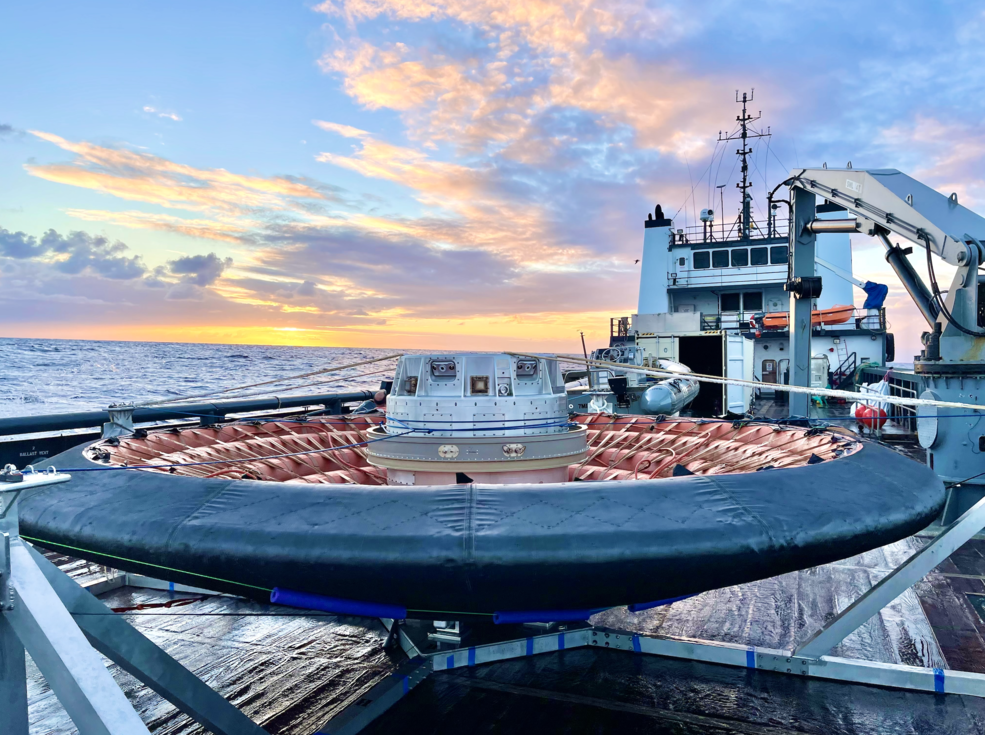
“Large-diameter aeroshells allow us to deliver critical support hardware, and potentially even crew, to the surface of planets with atmospheres,” said Trudy Kortes, director of Technology Demonstrations at NASA Headquarters. “This capability is crucial for the nation’s ambition of expanding human and robotic exploration across our solar system.”
NASA has been developing HIAD technologies for over a decade, including two smaller scale suborbital flight tests before LOFTID. In addition to this successful tech demo, NASA is investigating future applications, including partnering with commercial companies to develop technologies for small satellite reentry, aerocapture, and cislunar payloads.
“This was a keystone event for us, and the short answer is: It was highly successful,” said LOFTID Project Manager Joe Del Corso. “Our assessment of LOFTID concluded with the promise of what this technology may do to empower the exploration of deep space.”
Due to the success of the LOFTID tech demo, NASA announced under its Tipping Point program that it would partner with ULA to develop and deliver the “next size up,” a larger 12-meter HIAD aeroshell for recovering the company’s Vulcan engines from low Earth orbit for reuse.
The LOFTID team recently held a post-flight analysis assessment of the flight test at NASA’s Langley Research Center. Their verdict?
Upon recovery, the team discovered LOFTID appeared pristine, with minimal damage, meaning its performance was, as Del Corso puts it, “Just flawless.”
View some interesting visual highlights from LOFTID’s flight test.
LOFTID splashed down in the Pacific Ocean several hundred miles off the east coast of Hawaii and only about eight miles from the recovery ship’s bow – almost exactly as modeled. A crew got on a small boat and retrieved and hoisted LOFTID onto the recovery ship.
“The LOFTID mission was important because it proved the cutting-edge HIAD design functioned successfully at an appropriate scale and in a relevant environment,” said Tawnya Laughinghouse, manager of the TDM (Technology Demonstrations Missions) program office at NASA’s Marshall Space Flight Center.
Marshall supported the Langley-led LOFTID project, providing avionics flight hardware, including the data acquisition system, the inertial measurement unit, and six camera pods. Marshall engineers also performed thermal and fluids analyses and modeling in support of the LOFTID re-entry vehicle inflation system and aeroshell designs.
The LOFTID demonstration was a public private-partnership with ULA funded by STMD and managed by the Technology Demonstration Mission Program, executed by NASA Langley with contributions from across NASA centers. Multiple U.S. small businesses contributed to the hardware. NASA’s Launch Services Program was responsible for NASA’s oversight of launch operations.
First published at NASA.gov





